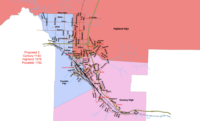POCATELLO — Pocatello High School principal Lisa Delonas is aware of her school’s reputation.
“We’ve been called ‘ghetto’ — and much worse,” Delonas said, acknowledging that some locals even identify Pocatello as the “druggie” school.
Pocatello’s public perception has little to do with the quality of instruction, Delonas argued, and a lot to do with a long history of unenforced high school boundaries.
For two decades, the Pocatello-Chubbuck School District has allowed students to choose between its three high schools. This policy originally helped balance enrollment, but ultimately led to a disproportionate share of low-income and learning-challenged students settling at Pocatello High School.
The open-enrollment policy also fueled perceptions:
- Highland High is known for its sports.
- Century High is known for its academics.
- Pocatello High is known for its poverty and students who struggle to fit in.
An 18-member committee of educators and parents recently drafted a plan to enforce high school boundaries. But the prospect of forcing hundreds of students to change schools has opened a floodgate of concerns and opinions, and sparked questions about why the policy was ever implemented.
Here’s a deeper look at how Pocatello-Chubbuck’s open-enrollment policy came to be, how it fueled a wide range of disparities across the district and how it set the stage for today’s school-boundary tug of war.
History lesson: two cities, two cramped high schools
Rewind 21 years.
It’s early 1997, and the Pocatello-Chubbuck School District’s two high schools, Pocatello and Highland, are overcrowded. The City of Pocatello and its sister city to the north, Chubbuck, have grown. However, the district has thrice failed to gain the supermajority of votes needed to pass a bond issue for new infrastructure.
The location for a new school emerged as a focal point in the debate, according to series of articles published in Pocatello’s Idaho State Journal. Patrons were torn between building a new school on either:
- a 46-acre, district-owned site on Pocatello’s southeast end, across Interstate 15 from Pocatello High School,
- or a 50-acre, $600,000 parcel for sale further north in growing Chubbuck, closer to Highland High.

Proponents of the northern site reiterated Chubbuck’s growth. South-site proponents argued that Chubbuck’s sewer system couldn’t handle the added stress.
After three failed attempts in four years, voters eventually decided in favor of the Pocatello location — a choice that would catch up with the district over the next 20 years.
Students migrate from Pocatello to Century
Century High opened its doors in 1999 and to boost its enrollment, the district opened high school boundaries. Students could attend any high school they wanted, as long as they could get themselves there.
Over time, Century’s enrollment climbed, but an unintended consequence was at play.
The new open-enrollment policy enticed Pocatello students in the school’s affluent southern neighborhoods, many of whom could self transport, to begin migrating to Century. These early migrators set off the slow but steady process of segregating Pocatello and Century along socioeconomic lines.
Today, about 70 percent of students in Pocatello High’s most affluent southern neighborhood, Johnny Creek, attend Century, according to Pocatello-Chubbuck business director Bart Reed.
Here’s a breakdown of students who qualify for free-and-reduced lunch at all three Pocatello-Chubbuck high schools in 2016-17:
- Pocatello: 48 percent
- Century: 37 percent
- Highland: 28 percent
Of the 482 students currently flooding into Century High School, 247 live within Pocatello High’s boundaries.
Chubbuck’s growth strains Highland
Further north, Highland had its own math problem after Century’s construction. Chubbuck’s continued growth was pushing the school over capacity.
Chubbuck grew from 9,700 in 2000 to 13,922 in 2010, a 30 percent increase, according to census data compiled by The City of Pocatello. These numbers eclipsed those in Pocatello, which grew from 51,460 in 2000 to 54,255 in 2010 — a 5 percent increase.
Highland’s further proximity from both Pocatello and Century and enforced enrollment caps from the district have shielded Highland from student influxes comparable to those in either of the other two high schools. Today, the district’s open-enrollment policy actually leaves Highland with 178 fewer students than it would otherwise have.
Yet Highland operates above its enrollment capacity of 1,500, further fueling efforts to redraw high school boundaries.
“If we closed all the borders right now, Highland would have even more students,” said Pocatello-Chubbuck spokeswoman Shelley Allen. In November, the 18-member committee charged with drafting a solution to end the district’s long-running open-enrollment policy pegged this number at 1,773.
School choice and performance trends
Parents, educators and students across the district agree that while Pocatello’s major appeal is social, Century’s is academic.
This year, The Washington Post named Century one of the nation’s most challenging schools. The school’s reputation was enough to entice senior Thomas Tallon to enroll when he moved into Pocatello High’s boundaries from Burley two years ago. Highland’s well-known sports programs were tempting, Tallon said, but Century’s pre-physical therapy coursework and overall academic reputation ultimately won out.
“I love sports, but I figured academics were most important,” Tallon said.
Pocatello High students Chandler Laurence and Mykah Johnson say their school does have some academic appeal. Johnson lives in Highland’s boundary, but makes the extra drive to Pocatello High for its art program. However, both girls agreed that social incentives, not necessarily academic ones, entice students to enroll at Pocatello High.
“Century and Highland are super cliquey,” Johnson said. “I just feel like kids can be themselves at Pocatello.”
Pocatello High principal Delonas agreed that her school has a lot of social appeal for students who struggle to fit in. She pointed to the school’s exclusive LGBT club, and higher ratio of special education students. (Pocatello’s special education enrollment surpasses Highland’s and Century’s by 4 percentage points and 3 percentage points, respectively, according to Pocatello-Chubbuck special services director Dave Miner.)
Delonas takes pride in her student population, but acknowledged her school doesn’t keep pace academically. Here is a breakdown of 2016-17 performance indicators between the three schools:
College go-on rates
- Century: 57 percent.
- Highland: 50 percent.
- Pocatello: 38 percent.
Average SAT scores:
- Century: Math: 526; Reading and writing: 534.
- Highland: Math: 507; Reading and writing: 525.
- Pocatello: Math: 474; Reading and writing: 489.
Average ISAT proficiencies (grades 3-8 and 10):
- Century: Math: 48 percent; English: 76 percent.
- Highland: Math: 41 percent; English: 69 percent.
- Pocatello: Math: 35 percent; English: 54 percent.
Backlash over newly proposed boundaries
Hundreds of patrons have grappled with the 18-member committee’s proposed boundary changeup currently being considered by the school board.
The controversy over these proposed boundaries swirls around two major areas:
- A large and growing residential swath south of Reservation Road and west of Hawthorne Road, which would be taken from Highland and given to Pocatello.
- The Johnny Creek and Gibson Jack neighborhoods, rural areas of affluence in Pocatello’s southern foothills, which would be taken from Pocatello and given to Century.
Pocatello-Chubbuck administrators estimate that these proposed changes would boost Pocatello’s enrollment to 1,182 students, while slightly reducing enrollment at both Century and Highland to 1,140 and 1,579, respectively. Reed estimates that the change would close the long-developed free-and-reduced-lunch gap between Pocatello and Century to within 2 percentage points.
But the prospect of having to switch schools has jolted many parents who say it burdens students with deep roots at the school.
“It’s a bad deal all the way around for us,” said Wade Barker, a Highland parent of three who could soon find his home annexed into Pocatello’s boundaries. “My kids wouldn’t fit in at Pocatello. They don’t smoke or chew or anything like that.”
Barker, who attended Highland, said his family “bleeds red and black” — the school’s colors. He also lamented the prospect of his eighth-grade son not being able to play football at Highland, like his older brother, who won a state championship with the team this school year.
Patrons regularly refer to Highland as the “football school.” Financial statements and Highland High School athletic director Travis Bell confirmed that Highland’s and Century’s football programs outspent Pocatello’s this year by well over $15,000. MaxPreps, a website covering high school sports across the nation, recently ranked Highland’s football program in the top 50, out of 16,000 schools nationwide.
“It’s an important part of our family,” Barker said.
Despite a number of similarly concerned Highland parents, Delonas, who also served on the committee, said the current proposal doesn’t do enough to balance Pocatello’s socioeconomic gaps.
She proposed moving 118 more students from Highland to Century to avoid further overcrowding at an already packed school, and allowing Pocatello to keep the affluent Johnny Creek and Gibson Jack areas, which Pocatello slowly lost to Century, thanks to open enrollment.
But letting Pocatello keep Johnny Creek and Gibson Jack is unlikely, Reed said. He pointed out that 70 percent of these kids already attend Century. Forcing them to Pocatello and extending the school’s boundaries north into Chubbuck would swing Pocatello to a socioeconomic advantage over the other schools.
“Simply moving one small area to another is not as simple as you might think,” Reed said.
Barker, the Highland parent, said: “I won’t sell my house and move if we get put in Pocatello’s boundaries — I’ll just give (the district) a false address, so (my kids) don’t have to go to there.”

